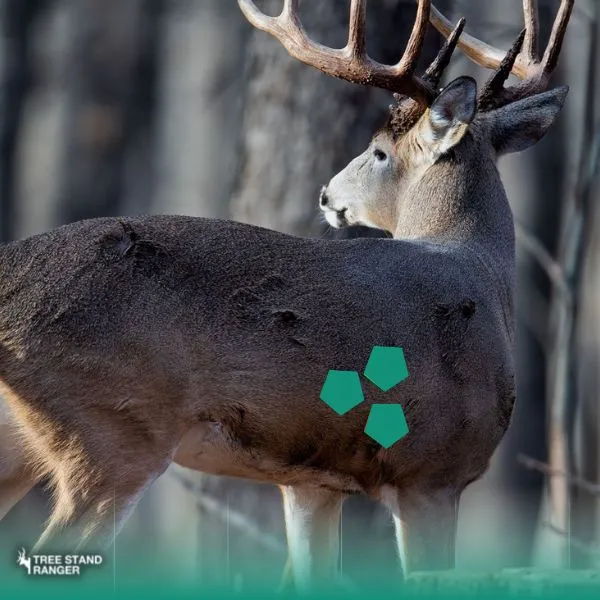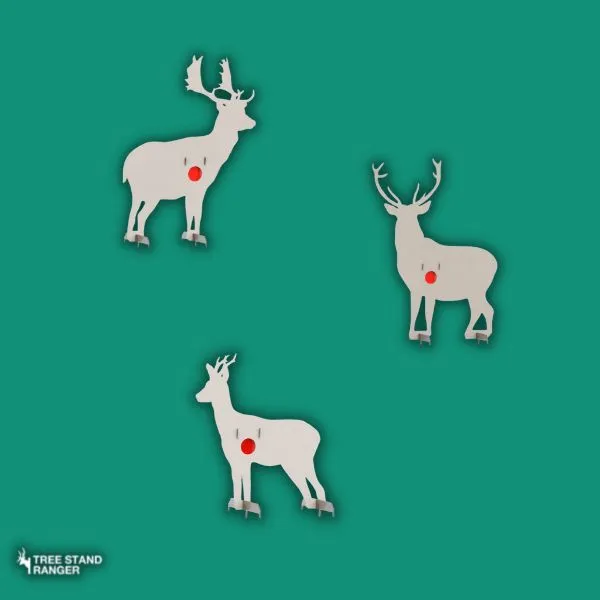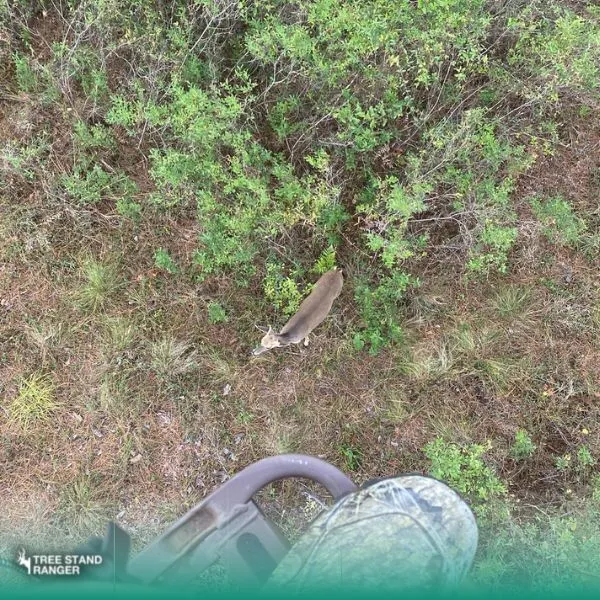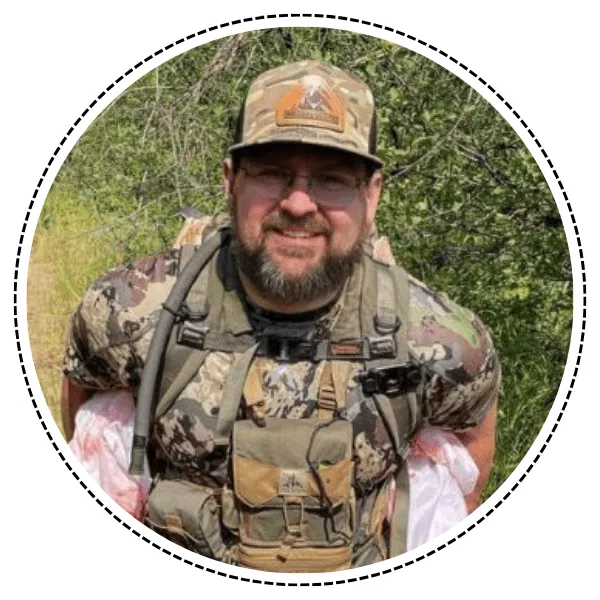You get different pre marked center points for different shooting methods. Bullseye is for target shooting, and 12-ring is for 3D targets. However, when bow hunting, you don’t get any marked spot regarding where to shoot deer with an arrow.
The most ideal position is when you can see the broadside of a buck. At that time, the vitals of that animal are easily exposed to you for taking a kill shot.
The best point to hit the deer with arrow is in line with the front leg and 1/3 way up. Doing so helps you with an unobstructed way right into the deer’s heart.
In most circumstances, opting for a frontal shot is ill advised. There are significant chances of missing deer’s vital organs and hurting the animal badly. Since bucks are extremely cautious, even the slightest noise of your bow can result in a string jump. That is when the deer drops its body down to dodge the shot.
Considering the complexities, it is foremost to learn how to start deer hunting and where to shoot deer with an arrow before entering the hunting grounds.
Deer Bow Shot Placement – Where To Shoot Deer With An Arrow?
Every bow hunter wants to shoot at the spot that becomes lethal for the animal. This saves the deer from excruciating pain. There are multiple shot placements that bow hunters can target. However, it is essential to have a powerful bow with fast FPS (feet per second), poundage, and the right broadhead.

The ideal place to shoot a buck is in its vitals where the heart, lungs, and liver are located. Even a single bow shot in any of these organs will result in killing the animal.
Some key factors for a kill shot include a sharp and solid broadhead. You should fire with a sufficient KE i.e., 25 ft-lbs. minimum and also be extremely accurate with the aiming. Make sure that your bow has a fire rate of 300 FPS. This will ensure that the arrow will reach the deer’s vital before it does a string jump.
Deer Anatomy For Bow Hunters Archery
You can’t expect a buck to stay in your desired position all the time. There would come moments when you won’t be able to get a broadside view of the animal. Rather than restricting yourself to taking a shot at the broadside only, know a deer’s archery anatomy.
The following deer vitals diagram show where the most sensitive organs are located in a buck’s body.

Where To Shoot A Deer With A Bow?
As mentioned earlier, the best view you can get to shoot a deer would be from the broadside. There are five main positions where strategies for firing at the buck change. These include frontal, broadside, quartering toward, quartering away, and the string jump.
It happens quite commonly when a deer won’t change its body orientation for a long time. This keeps the hunter confused about whether to take the shot or not. As the animal moves out of sight, it takes away the opportunity as well.
That is when you should know the right bow shot placement spots regardless of deer’s position. Be confident with the fire and make sure to have an accurate aim.
Frontal Shot
This is the most difficult body orientation of deer for bow hunters. The frontal side is when a buck faces the archer. At this point, the majority of the people don’t risk taking a shot and wait for the animal to turn.
Sometimes, the buck stays like that for quite some time and hops away in the same position within the blink of an eye. This fades away the chance of taking it down. The best practice at this time is to use a grunt call or rattling antlers to stop the animal.

Doing so might move the deer and give you a quartering away or broadside shot. However, if you don’t get the right view, it’s better to miss the shot rather than taking a bad one and wound the deer.
Generally, the frontal shot is only possible if you hit the accurate spot just beneath the throat patch. It is as small as a baseball and the best distance to shoot from is between 15 to 30 yds. This could prove to be a devastating shot for the buck if executed perfectly which is highly rare.
Broadside Shot
Just behind the shoulder bones, the broadside shot is the largest part in sight of a hunter. When a buck is standing on its broadside, all of its vital organs are exposed to the hunter for taking a kill shot.
A lot of hunters worry about hitting the arrow in deer ribs while targeting its main organs. However, any arrow with a solid broadhead is capable of penetrating through the ribs and reaching the vitals.
Therefore, make sure to have the right broadhead tipped. So, even if you get a deer rib cage arrow shot, it will break through it and reach the heart or lungs.
Based on where you are shooting from, the placement, angles, and tactics might differ a bit.
Eye Level Shots
The most accurate shots are taken from the ground. Understand how to read deer trails to position yourself better. When deer is close, aim the dead center directly in line with the shoulder before the front legs and about 1/3rd of the way up. Keep the buck’s heart in mind which is located at an angle of 45 degrees.
With this shot, you will take down the animal immediately. Though it will run a little but will also leave an intense blood trail, making it easier for you to find. If the deer is slightly elevated than you, aim a bit lower.
If you shoot an inch higher than the main point, the arrow will hit the top part of the deer’s heart and both lungs. However, when shot a little right/left, it might miss the heart but hit the lungs. Lastly, if the arrow hits further back, it will enter the liver territory.
When you are on the ground and have numerous brushes around, shooting the big game animal could be tricky. This is one of the major obstructions that hunters encounter from the eye level. Just because something is covering the vitals of a deer doesn’t mean your arrow can’t reach it.
While shooting through a brush, the key to an accurate shot is the appropriate usage of sight pins. Make sure that the pin aims right into the deer’s vitals and that there are no obstructions in the line of sight.
If the buck is at a distance of 30 yds., the sight pin for 30 yds. should aim at the animal’s vital spot. Whereas, if there are brushes at a distance of 20 yds., the respective sight pin should not have an obstacle in line. In case it does, the arrow will knock on the brush. However, if the sight of obstruction is clear, it will hit directly into the trophy animal’s vital spot.
Undoubtedly, such shots are extremely risky and require immense precision, steadiness, and accuracy. That said, many hunters opt to leave such shots rather than risk the buck’s life.
Hunting From Elevated Position
Hunters love shooting from higher elevations because of a clearer view and an unusual camouflage. If scent is absent, tree stand camouflaged and there is no sound, deer can’t notice a hunter above his head. Moreover, camo-patterned cloth are used as well.
The bucks are extremely clever and tend to dodge most broadside shots from heights via string jump. Aim accurately and visualize the shot before firing. For a lethal shot, target the vertical midpoint right behind the elbow of a deer’s front leg.
If the arrow is fired at the appropriate spot, it will either give a heart and lung shot or a double lung shot. Either way is humane enough to take down the trophy animal.
Quartering Toward
As suggested by the name, it is when the animal is facing you but has a specific angle. Everything is good except for the angle, making the shot tricky.
Eye Level
Make sure to only take the shot if you are an expert in bowhunting. The target to aim should be behind the elbow of whichever leg is in the lead. The best distance to shoot is within 15 yds.
If the buck is standing with both legs aligned, wait for it to take a step and then aim the lead leg. All your focus should be on hitting right into the liver or lungs. Don’t shoot at the shoulder socket since it doesn’t cross any vital organ and injure the animal badly.
Elevated
If the buck doesn’t change its body orientation, determine its lead leg and aim right above and behind its elbow. As soon as the deer takes a step, shoot at the spot and if done right, the arrow will hit its liver and lungs.
Though it is not very ideal to take a quartering-to shot from a treestand. Only professionals with top-notch aims and expertise can hit at the vitals from such positions.
Quartering Away
Since the trophy animal is moving in the opposite direction, it has fewer chances of seeing you. It is the contradictory of quartering toward i.e., the animal moves away from the hunter with a certain angle. This position exposes all of the deer’s vital organs to the bowhunter.
Eye Level
Rather than shooting at the front shoulder, make sure to aim slightly back i.e., at the opposite shoulder. This is where the arrow will exit after going through the animal’s vitals. The accurate shot will result in a graphic blood trail.
Elevated
This is probably the most ideal deer body orientation for hunters on treestands. It not only offers a wide range of organs to hit but also reduces the likelihood of string jumping. Just like you aim from the ground level, target the opposite shoulder of the buck.
The entry point might not look right to you but make sure to aim accurately and it will easily pass through the vitals.
Deer String Jumping
Deer has a unique ability to drop their body down as soon as they sense the release of an arrow. This saves the animal’s vitals and it runs away, making your shot a useless one. A buck with its head down is likely to react a lot quicker than one with its heads up.
If you are more than 20 to 25 yds. away, aim slightly lower i.e., the bottom of the kill zone. If the deer string jumps, it will hit it right in the vitals. However, if it doesn’t, you will still get a shot crossing the bottom of both lungs and sometimes the heart too.
When the animal is within the range of 20 yds., aim directly on its vitals. Considering the fire rate of modern bows, deer wouldn’t have much time to react.
Bad Bow Shots On Deer
Regardless of your expertise and accuracy, you never know when a bow can malfunction. Sometimes, a deer’s unexpected movement can also result in a bad shot or an edge shot. Nothing is worse than a gut shot deer with bow.
Since it is not lethal, the animal goes through excruciating pain, leading to a slow death. A gut shot deer reaction also hints at how badly it is hurt. As you hit there, the buck will hunch up its body and jog away.
Sometimes, aiming inaccurately leads to edge shooting which misses the target. One of the main reasons is deer string jumping which results in the arrow either missing or hit on the edge.
Where to shoot a deer from a treestand?
You need to shoot deer vitals from tree stand. When deer moves, one leg is is slightly forward. That’s when you hit the vitals from front. Hunters on treestand face this issue quite commonly due to angle issues. Also, it’s mandatory to practice from a treestand if you hunt from there. The key to preventing edge shooting from an elevation is to slightly bend at the waist when firing. A shot without bending at the waist will fail you every single time.
Next thing is to judge the distance as accurately as you can. This is only possible if you practice excessively from various heights. Keeping these factors in mind, you can overcome the failure of bad shots and edge shooting.
How Long Does A Deer Live After Being Shot?
After shooting the deer in its main organs, it still manages to escape the ground. It makes the hunters wonder that can a deer survive with an arrow in it. Well, it can take from a couple of minutes to about half an hour depending on how much damage is done.
If it is hit directly in the heart, it would go down within some minutes. However, if the arrow didn’t cross the heart directly but other vitals, it can run away as far as 100 yds. and stay alive for 30 minutes.
A high lung shot deer doesn’t realize it has been hit. However, a double lung shot whether high or not will keep the animal alive for about 20 seconds. If a whitetail runs at 35 mph, how far can a deer run after being shot high in the lungs? Surprisingly, it will cover about 300 yds. in 20 seconds.
How To Track A Wounded Deer?
To strive as a successful deer bow hunter, you should know how to track a wounded deer even when there is no blood on arrow. The foremost thing to do right after you shoot is to closely determine how the deer reacts.
If it jumps high and the mule kick (kick its hind legs) it indicates that the arrow has hit right into the heart or lungs. In this case, a deer can’t go further than 100 yds. Similarly, if you notice the animal hunching up its body while lowering its head, you might have hit it in the guts or liver.
Lastly, if the buck becomes still and runs away with its tail up, it indicates that you have missed the shot. Now, how far do deer travel? it is definitely not coming back in this are due to hunting pressure.
Wait for at least 20 to 30 minutes after taking the shot and then start investigating. Look around for broken branches, deer hair or blood, deeper tracks, and best of all, blood. Mark the trail with flagging tape for your convenience.
Keep following unless you find any blood spots. Once you do, start following it and you will be led to a pool of blood with your target down.
Deer Blood Trail Types
The blood color and consistency help you track down the deer and determine the exact body part where the arrow hit. Following are some scenarios that might have happened depending on the color and consistency of blood.
- Bright Red
If you find the blood sprayed on the ground and has a rich red color, it is likely to be a direct heart shot. Keep following the blood trail and you will get to your dead prey.
- Dark Red or Maroon
Is the blood extremely dark red – almost maroon and has a watery consistency? It is a liver shot blood trail. If you have gone for tracking after 20 minutes of the shot and noticed this kind of blood, the deer is still alive.
If you wonder how long can a liver shot deer live, the answer could be 3 to 4 hours. That said, you might have to wait at least two hours before proceeding forward and finding the animal safely.
- Reddish Pink
A frothy and bubbly reddish pink blood specifies an extremely lethal shot taken on the lungs and heart combined. At this moment, the deer might already be dead or would be about to die in a couple of minutes. It is better to wait around 10 to 15 minutes before moving further.
- Yellow/Blue/Green
The grossest of all and with an awful smell along a watery consistency, this kind of blood indicates a gut shot. While such shots can be fatal but give a deer slow death along with a septic shock.
You can find a buck with a gut shot within 150 to 200 yds. distance. It is better to return to the ground a couple of hours later.
- Heavy Red At The Shooting Site
Sometimes, you might notice a small pool of heavy red blood which fades away as you move forward. This is generally known as the muscle shot deer blood trail. It happens when the arrow has hit either the leg or neck.
You can keep following the path even when the tracking deer blood trail stops. Look for other signs and keep marking the route. Once you found your buck, start cutting it into pieces and packing. For that learn how to pack out hunted deer.
Conclusion
The anticipation, adrenaline rush, and concentration while figuring out where to shoot deer with an arrow is unparalleled. Despite trying their best to shoot the animal in the spot hunters fail. This is because they don’t execute the shot well.
Make sure to consider various situations before firing the arrow including the buck’s reaction. Also, know the correct bow placement shots and only take those that you have practiced for so you don’t hurt the animal.
Frequently Asked Questions (FAQ’s)
On rainy days, tracking a deer with no blood trail could be slightly tricky. Make sure to inspect the sight of impact carefully and look for all the other signs. If there’s light rain, you might still find some blood. However, it is best to look around for deer steps, overturned leaves, and broken branches.
Many hunters ask can a deer survive a gut shot and if not, how far can it run. Well, it cannot survive a gut shot but can run a couple of miles due to slow death. You might have to wait around 6 to 8 hours before trailing the blood.

About Alex David
I am an avid bow hunter and author of Tree Stand Ranger. Hunting from tree stands has been a passion of mine for many years. I’ve had the privilege of owning several tree stands and hunting properties throughout my life, and I take great pride in having the opportunity to do so. Read more about me.
Related Hunting Guides
Tree Stand Hunting
- Best Tree Stand For Bow Hunting Deer 2024
- Best Ladder Tree Stand For Bow Hunting 2024
- Best 2 Man Ladder Stand 2024
- Best Climber Tree Stand 2024
- Best Hang On Tree Stand 2024
- Best Quadpod Deer Stand 2024
- Best Tripod Hunting Stand 2024
- Best Saddle Platform 2024
- Best Run and Gun Tree Stand 2024
- Best Budget Tree Stands 2024





Leave a Reply